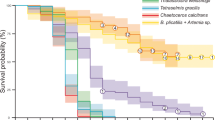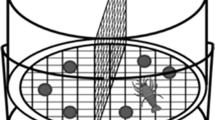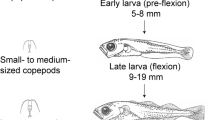Abstract
Whilst the role of chemoreception in juvenile crustacean feeding behaviour has received considerable attention, the chemosensory responses of larval planktonic crustacean stages have been neglected. The present study investigated the acceptability of processed, microparticulate and microencapsulated diets and the possible role of chemoattractants for larval and juvenile stages ofHomarus gammarus (Linnaeus) and juvenile stages ofPalaemon elegans (Rathke). Larval and juvenile lobster were obtained from MAFF (Ministry of Agriculture, Fisheries and Food, Conwy, UK), and juvenileP. elegans were collected from the Menai Straits (Gwynedd, UK) during the summer months of 1985/1986. During the larval stages, food capture results from chance encounter, and the role of low molecular-weight chemoattractants appears to be in the determination of the edible from the inedible. Dietary conditioning behaviour in decapod larvae, which has until now not been investigated, enables the larvae to discriminate more rapidly between particles of different digestibilities. The digestibility and assimilation efficiency displayed on artificial diets in the present study suggest that lobster larvae possess limited enzymatic capabilities, although later stages are more efficient and display longer food-retention time. Growth (0.114 mm d−1) and survival (80.0%) of lobster larvae fed natural diets were significantly better (F=14.8;P=0.001, andF=54.0,P=0.001, respectively) than of individuals fed artificial diets. Although pre-digested artificial diets (ingredients pre-treated with pancreatin) resulted in higher survival (74 and 63%) compared to microencapsulated diets (37%), there was no significant growth difference between the artificial diets tested.
Similar content being viewed by others
Literature cited
Abdel-Rahman, S. H., Kanazawa, A., Teshima, S. (1979). Effects of dietary carbohydrates on the growth and the levels of the hepatopancreas glycogen and serum glucose of prawn. Bull. Jap. Soc. scient. Fish. 45: 1491–1494
Ache, B. W. (1982). Chemoreception and thermoreception. In: Atwood, H. L., Sandeman, D. C. (eds.) The biology of Crustacea. Vol. 3. Academic Press, N. Y., London, p. 369–398
Adron, J. W., Blair, A., Cowey, C. B. (1974). Rearing of plaice (Pleuronectes platessa) larvae to metamorphosis using an artificial diet. Fish. Bull. U.S. 72: 353–357
Anger, K., Storch, V., Anger, V., Capuzzo, J. M. (1985). Moult cycle and hepatopancreas of lobster larvae. Helgoländer wiss. Meeresunters. 39: 107–116
Barker, P. L., Gibson, R. (1977). Observations on the feeding mechanism, structure of the gut and digestive physiology of the European lobsterHomarus gammarus (L.) (Decapoda: Nephropidae). J. exp. mar. Biol. Ecol. 26: 297–324
Brockerhoff, H., Hoyle, R. J., Hwang, D. C. (1970). Digestive enzymes of the American lobster (Homarus americanus). J. Fish. Res. Bd Can. 27: 1357–1370
Carr, W. E. S. (1978). Chemoreception in the shrimpPalaemonetes pugio: the role of amino acids and betaine in elicitation of a feeding response by extracts. Comp. Biochem. Physiol. 61A: 127–131
Carr, W. E. S., Ache, B. W., Gleeson, R. A. (1987). Chemoreceptors of crustaceans: similarities to receptors for neuroactive substances in internal tissues. Envir. Hlth Perspectives 71: 31–46
Carr, W. E. S., Blumenthal, K. M., Netherton, J. C. (1977). Chemoreception in the pigfish,Orthopristis chrysopterus: the contribution of amino acid and betaine to stimulation of feeding behaviour by various extracts. Comp. Biochem. Physiol. 58A: 69–73
Carr, W. E. S., Chaney, T. B. (1976). Chemical stimulation of feeding behaviour in the pinfish,Lagodon rhomboides: characterization and identification of stimulatory substances extracted from the shrimp. Comp. Biochem. Physiol. 54A: 437–441
Case, J. (1964). Properties of the dactyl chemoreceptors ofCancer antennarius stimpson andC. productus Randall. Biol. Bull. mar. biol. Lab., Woods Hole 127: 428–446
Castell, J. D., Kean, J. C. (1986). Evaluation of the role of nutrition in lobster recruitment. Can. J. Fish. aquat. Sciences 43: 2320–2327
Chang, E. S., Conklin, D. E. (1983). Lobster (Homarus) hatchery techniques. In: McVey, J. P. (ed.) CRC handbook of mariculture, crustacean aquaculture. Vol. 1. Boca Raton, Florida, USA, CRC Press Inc., p. 271–275
Clark, J., Jones, D. A., Kurmaly, K. (in preparation). Penaeid larval rearing on microencapsulated feeds. In: Volker, C. M., Volker, A. (eds.) First Inter-American Congress of Aquaculture, 14–21 September 1986. Salvador, Brazil
Condrey, R. E., Gosselink, J. G., Bennet, H. J. (1972). Comparison of the assimilation of different diets for juvenilePenaeus setiferus andPenaeus aztecus. Fish. Bull. U.S. 70: 1281–1292
Conklin, D. E., D'Abramo, L. R., Norman-Boudreau, K. (1983). Lobster nutrition. In: McVey, J. P. (ed.) CRC handbook of mariculture, crustacean aquaculture. Vol. 1. Boca Raton, Florida, USA, CRC Press Inc., p. 413–423
Conover, R. J. (1966a). Assimilation of organic matter by zooplankton. Limnol. Oceanogr. 11: 338–345
Conover, R. J. (1966b). Factors affecting the assimilation of organic matter in zooplankton and the question of superfluous feeding. Limnol. Oceanogr. 11: 346–354
D'Abramo, L. R., Baum, N. A., Bordner, C. E., Conklin, D. E. (1983). Carotenoids as a source of pigmentation in juvenile lobsters fed a purified diet. Can. J. Fish. aquat. Sciences 40: 699–704
D'Abramo, L. R., Bordner, C. E., Conklin, D. E., Baum, N. A. (1984). Sterol requirement of juvenile lobsters,Homarus sp. Aquaculture, Amsterdam 42: 13–25
D'Abramo, L. R., Wright, J. S., Wright, K. H., Bordner, C. E., Conklin, D. E. (1985). Sterol requirement of cultured juvenile crayfish,Pacifastacus leniusculus. Aquaculture, Amsterdam 49: 245–255
Dadd, R. H. (1970). Arthropod nutrition. Chem. Zool. 5: 35–95
Dabrowski, K., Glogowski, J. (1977a). Studies on the role of exogenous proteolytic enzymes in digestion processes in fish. Hydrobiologia 54: 129–134
Dabrowski, K., Glogowski, J. (1977b). Studies on the proteolytic enzymes of invertebrates constituting fish food. Hydrobiologia 52: 171–174
Dall, W., Moriarty, D. J. W. (1983). Functional aspects of nutrition and digestion. In: Mantel, L. H. (ed.) The biology of Crustacea. Vol. 5. Academic Press, N. Y., London, p. 215–262
Dick, J., Felber, J.-P. (1975). Specific hormonal regulation, by food, of the pancreas enzymatic (amylase and trypsin) secretions. Hormonal metab. Res. 7: 161–166
Donaghay, P. L., Small, L. F. (1979). Food selection capabilities of the estuarine copepodAcartia clausi. Mar. Biol. 52: 137–146
Eagles, M. D., Aiken, D. E., Waddy, S. L. (1984). Effect of food quality and feeding schedule on survival, growth and development of larval American lobsters fed frozen brine shrimp. J. Wld Maricult. Soc. 15: 142–143
Eagles, M. D., Aiken, D. E., Waddy, S. L. (1986). Influence of light and food on larval American lobsters,Homarus americanus. Can. J. Fish. aquat. Sciences 43: 2303–2310
Factor, J. R. (1981). Development and metamorphosis of the digestive system of larval lobsters,Homarus americanus (Decapoda: Nephropidae). J. Morph. 169: 225–242
Fange, R., Grove, D. (1979). Digestion. In: Hoar, W. S., Randall, D. J., Brett, J. R. (eds.) Fish physiology, bioenergetics and growth. Vol. 8. Academic Press, London, p. 162–260
Fluchter, J. (1980). Review of the present knowledge of rearing whitefish (Coregonidae) larvae. Aquaculture, Amsterdam 19: 191–208
Forster, J. R. M., Beard, T. W. (1973). Growth experiments with the prawnPalaemon serratus fed with fresh and compounded foods. Fishery Invest., Lond. (Ser. 2) 27: 1–16
Frank, J. R., Sulkin, S. D., Morgan, R. P., II. (1975). Biochemical changes during larval development of the xanthid crabRhithropanopeus harrisii. I. Protein, total lipid, alkaline phosphatase, and glutamic oxaloacetic transaminase. Mar. Biol. 32: 105–111
Gabbott, P. A., Jones, D. A., Nichols, D. H. (1975). Studies on the design and acceptability of micro-encapsulated diets for marine particle feeders. II. Bivalve molluscs. Proc. 10th Eur. mar. Biol. Symp. 1: 127–141 [Persoone, G., Jaspers, E. (eds.) Universa Press, Wetteren, Belgium]
Galgani, F., Benyamin, Y. (1985). Radioimmunoassay of shrimp trypsin: application to the larval development ofPenaeus japonicus Bate, 1888. J. exp. mar. Biol. Ecol. 87: 145–151
Gibson, R. (1982). Feeding and digestion in decapod crustaceans. In: Pruder, G. D. et al. (eds.) Proceedings of the 2nd International Conference on Aquaculture Nutrition: Biochemical and Physiological Approaches to Shellfish Nutrition. 27–29 October 1981. Louisiana State University, Baton Rouge, p. 43–56. (Spec. Publs Wld. Maricult. Soc. No. 2)
Grant, P. T., Mackie, A. M. (1974). Chemoreception in marine organisms. Academic Press, London, p. 234
Heinen, J. M. (1980). Chemoreception in decapod Crustacea and chemical feeding stimulants as potential feed additives. Proc. Wld Maricult. Soc. 11: 319–334
Hindley, J. P. R. (1975). The detection and location of food by juvenile banana prawns,Penaeus merguiensis. Mar. Behav. Physiol. 3: 193–210
Hinton, D. J., Corey, S. (1979). The mouthparts and digestive tract in the larval stages ofHomarus americanus. Can. J. Zool. 57: 1413–1423
Holland, D. L. (1978). Lipid reserves and energy metabolism in the larvae of benthic marine invertebrates. In: Malins, D. C., Sargent, J. R. (eds.) Biochemical and biophysical perspectives in marine biology. Vol. 4. Academic Press, London, p. 85–123
Howard, F., Yudkin, J. (1963). Effect of dietary change upon the amylase and trypsin activities of the rat pancreas. Br. J. Nutr. 17: 281–294
Jancarik, A. (1964). Die Verdauung der Hauptnahrstoffe beim Karpfen. Z. Fisch. 12: 601–684
Jones, D. A., Holland, D. L., Jabborie, S. (1984). Current status of micro-encapsulated diets for aquaculture. Appl. Biochem. Technol. 10: 275–288
Jones, D. A., Kanazawa, A., Ono, K. (1979a). Studies on the nutritional requirements of the larval stages ofPenaeus japonicus using microencapsulated diets. Mar. Biol. 54: 261–267
Jones, D. A., Kanazawa, A., Rahman, S. A. (1979b). Studies on the presentation of artificial diets for rearing the larvae ofPenaeus japonicus Bate. Aquaculture, Amsterdam 17: 33–43
Jones, D. A., Kurmaly, K., Arshad, A. (1987). Penaeid shrimp hatchery trials using microencapsulated diets. Aquaculture, Amsterdam 64: 133–146
Kanazawa, A., Koshio, S., Teshima, S. (1989). Growth and survival of larval Red Sea breamPagrus (sic)major and Japanese flounderParalichthys olivaceus fed microbound diets. J. Wld Aquacult. Soc. 20: 31–37
Kanazawa, A., Teshima, S., Tokiwa, S. (1977). Nutritional requirements of prawn. VII. Effect of dietary lipids on growth. Bull. Jap. Soc. scient. Fish. 43: 849–856
Kean, J. C., Castell, J. D., Boghen, A. G., D'Abramo, L. R., Conklin, D. E. (1985). A re-evaluation of the lecithin and cholesterol requirements of juvenile lobsterHomarus americanus using crab protein-based diets. Aquaculture, Amsterdam 47: 143–149
Kean, J. C., Castell, J. D., Trider, D. J. 81984). Juvenile lobster (Homarus americanus) do not require dietary ascorbic acid. Can. J. Fish. aquat. Sciences 42: 368–370
Kondo, T. (ed.) (1979). Microencapslation (sic): new techniques and application. (Proc. 3rd int. Symp. Microencapslation) Techno Inc., Tokyo
Kurmaly, K. (1989). Studies on the acceptability and digestibility of artificial diets by Crustacea. PhD thesis, University College of North Wales, UK
Kurmaly, K., Jones, D. A. (in preparation). Physiological energetics of the larval development ofHomarus gammarus.
Kurmaly, K., Jones, D. A. Yule, A. B., East, J. (1989a) Comparative analysis of the growth and survival ofPenaeus monodon (Fabricius) larvae, from protozoea 1 to postlarva 1, on live feeds, artificial diets and on combinations of both. Aquaculture, Amsterdam 89: 27–45
Kurmaly, K., Yule, A. B., Jones, D. A. (1989b). An energy budget for the larvae ofPenaeus monodon (Fabricius). Aquaculture, Amsterdam 89: 13–25
Laubier-Bonichon, A., Van Wormhoudt, A., Sellos, D. (1977). Croissance larvaire contrôlée dePenaeus japonicus Bate. Enzymes digestives et changement de régimes alimentaires. Third meeting of Groupe Mariculture, Brest, France, May 10–13, 1977. Publs Cent. natn. Exploit. Océans (CNEXO) (Sér. Act. Colloques) 4: 131–145
Laverack, M. S. (1963). Aspects of chemoreception in crustacea. Comp. Biochem. Physiol. 8: 141–151
Laverack, M. S. (1988). Larval locomotion, sensors, growth and their implications for the nervous system. In: Fincham, A. A., Rainbow, P. S. (eds.) Aspects of decapod crustacean biology. Clarendon Press, Oxford, p. 103–122
Lee, P. G., Norman, J. B., Rodrick, G. E. (1980). A quantitative analysis of digestive enzymes for the freshwater prawnMacrobrachium rosenberghii. Proc. Wld Maricult. Soc. 11: 392–402
Logan, D. T., Epifanio, C. E. (1978). A laboratory energy balance for the larvae and juveniles of the American lobsterHomarus americanus. Mar. Biol. 47: 381–389
Maugle, P. D., Deshimaru, O., Katayama, T., Simpson, K. L. (1982). Effect of short necked clam diets on shrimp growth and digestive enzyme activities. Bull. Jap. Soc. scient. Fish. 48: 1759–1764
Mayzaud, P. (1986). Digestive enzymes and their relation to nutrition. In: Corner, E. D. S., O'Hara, S. C. M. (eds.) The biological chemistry of marine copepods. Clarendon Press, Oxford, p. 165–225
Meyers, S. P. (1973). Capsulation techniques, development of diets for larval and post-larval aquatic animals. Feedstuffs, Lond. 45: 35–36
Meyers, S. P. (1979). Formulation of water-stable diets for larval fishes. Proc. Wld Symp. Finfish Nutr. Fishfeed Technol. 2: 14–20. [Halver, J. E., Tiews, K. (eds.) Berlin]
Moller, T. H., Jones, D. A., Gabbott, P. A. (1979). Further developments in the microencapslation of diets for marine animals used in aquaculture. In: Kondo, T. (ed.) Microencapslation (sic): new techniques and application (Proc. 3rd int. Symp. Microencapslation) Techno Inc., Tokyo, p. 223–229
Moriarty, D. J. W., Barclay, M. C. (1981). Carbon and nitrogen content of food and the assimilation efficiencies of penaeid prawns in the Gulf of Carpentaria. Aust. J. mar. Freshwat. Res. 32: 245–251
Paffenhöfer, G.-A., Van Sant, K. B. (1985). The feeding response of a marine planktonic copepod to quantity and quality of particles. Mar. Ecol. Prog. Ser. 27: 55–65
Pandian, T. J. (1967). Changes in chemical composition and calorific content of developing eggs of the shrimp,Crangon crangon. Helgoländer wiss. Meeresunters. 16: 216–224
Pandian, T. J. (1969). Yolk utilization in the gastropodCrepidula fornicata. Mar. Biol. 3: 117–121
Pandian, T. J. (1970). Ecophysiological studies on the developing eggs and embryos of the European lobsterHomarus gammarus. Mar. Biol. 5: 154–167
Phillips, B. F., Sastry, A. N. (1980). Larval ecology. In: Cobb, J. S., Phillips, B. F. (eds.) The biology and management of lobsters. Vol. 2. Ecology and management. Academic Press Inc., London, p. 11–57
Roman, M. R. (1984). Utilization of detritus by the copepod,Acartia tonsa. Limnol. Oceanogr. 29: 949–959
Samain, J. F., Moal, J., Daniel, J. Y., Le Coz, J. R. (1980). The digestive enzymes amylase and trypsin during the development ofArtemia: effect of food conditions. In: Persoone, G., Sorgeloos, P., Roels, O., Jaspers, E. (eds.) The brine shrimpArtemia. 2. Universa Press, Wetteren, Belgium, p. 239–255
Sastry, A. N. (1983). Pelagic larval ecology and development. In: Vernberg, F. J., Vernberg, W. B. (eds.) The biology of Crustacea. Vol. 7. Behavior and ecology. Academic Press, N. Y., London, p. 214–282
Scarratt, D. J. (1973). Abundance, survival, and vertical and diurnal distribution of lobster larvae in Northumberland Strait, 1962–63, and their relationship with commercial stocks. J. Fish. Res. Bd Can. 30: 1819–1824
Schoener, T. W. (1971). Theory of feeding strategies. A. Revs Ecol. 42: 369–404
Stroband, H. W. J., Dabrowski, K. R. (1979). Morphological and physiological aspects of the digestive system and feeding in fresh-water fish larvae. In: Fontaine, M. (ed.) Nutrition des poissons. Centre National de la Recherche Scientifique, Paris, p. 355–374. (Act. Colloque C.N.E.R.N.A.)
Van Weel, P. B. (1970). Digestion in Crustacea. In: Florkin, M., Sheer, B. T. (eds.) Chemical zoology. Vol. 5. Arthropoda, Part A. Academic Press, New York, p. 97–115
Van Wormhoudt, A. (1973). Activite des protéases des amylases et des protéines solubles au cours du développement larvaire chezPalaemon serratus. Mar. Biol. 19: 245–248
Van Wormhoudt, A., Ceccaldi, H. J., Martin, B. J. (1980). Adaption de la teneur en enzymes digestives de l'hepatopancrease dePalaemon serratus (Crustacea, Decapoda) a la composition d'aliments experimentaux. Aquaculture, Amsterdam 21: 63–78
Williams, L. W. (1907). The stomach of the lobster and the food of the larval lobster. Rep. Rhode Isl. Commnr inld Fish. 37: 153–180
Wojtowicz, M. B., Brockerhoff, H. (1972). Isolation and some properties of the digestive amylase of the American lobster (Homarus americanus). Comp. Biochem. Physiol. 42: 295–302
Yule, A. B. (1982). The application of new techniques to the study of planktonic organisms. PhD thesis, University College of North Wales, UK
Author information
Authors and Affiliations
Additional information
Communicated by J. Mauchline, Oban
Rights and permissions
About this article
Cite this article
Kurmaly, K., Jones, D.A. & Yule, A.B. Acceptability and digestion of diets fed to larval stages ofHomarus gammarus and the role of dietary conditioning behaviour. Mar. Biol. 106, 181–190 (1990). https://doi.org/10.1007/BF01314799
Accepted:
Issue Date:
DOI: https://doi.org/10.1007/BF01314799




